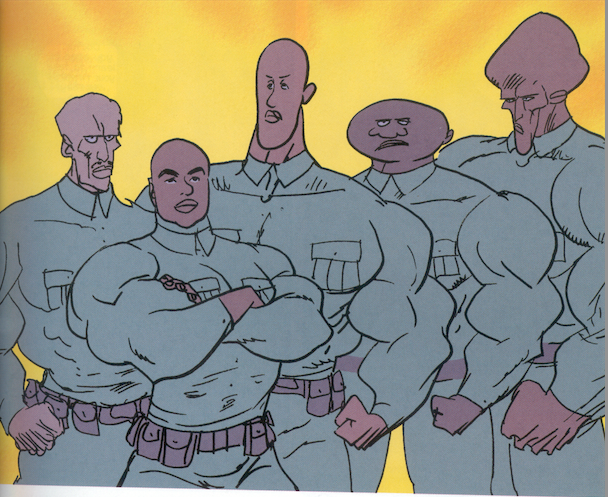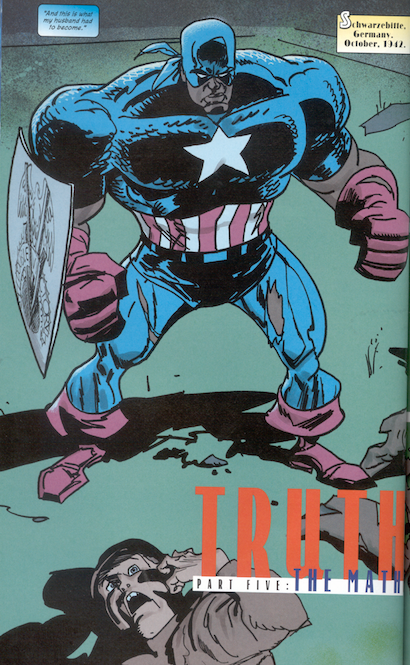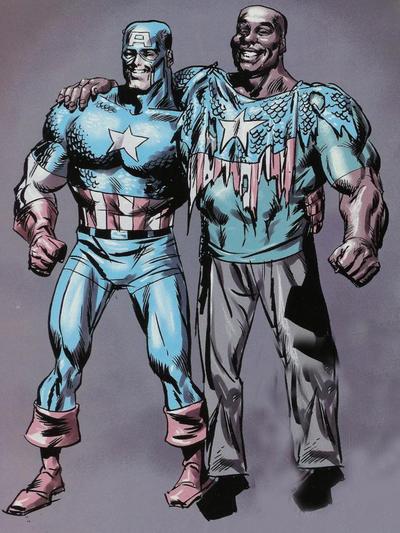Can a black man stand for America?
Barack Obama is one answer to that question — and a somewhat complicated one given the conspiracy theory birther nonsense that has been belched up in the wake of his presidency. Another answer is the upcoming Captain America arc, in which Sam Wilson, formerly the Falcon, is going to don the Cap uniform.
We don’t know yet how Marvel will approach the issue of a Black man as an icon of Americanness. But we do know how they addressed it once before, in the 2003 mini-series Truth: Red, White, and Black — a mini-series written by the late Robert Morales and drawn by Kyle Baker. Morales and Baker have very specific, very complicated thoughts on what it means for a black man to be America — and most of those thoughts are really, really depressing.
To understand what Morales and Baker are doing in Truth, you have to recognize that not just Captain America, but superheroes more broadly, have from their inception been obsessed with Americanness — and with assimilation. The Jewish creators Jerry Siegel and Joe Shuster inaugurated the genre with an immigrant from another planet who is adopted by friendly middle-Americans, and becomes the perfect, iconic personification of American strength and the American way. The Clark Kent identity can be seen as a kind of buried Jewish self, uneasily replicating stereotypes about emasculated, nerdy Semites. That’s true for Captain America too, to some degree. Created by Joe Simon and Jack Kirby, both Jews, the weak, spindly non-manly Steve Rogers takes the magic super-soldier formula and becomes the ur-American. More recently, G. Willow Wilson has played with this in Ms. Marvel, creating a young Muslim girl who (at least in the first few issues) transforms into a blonde-haired white-skinned Caucasian when she goes superheroing. Gene Luen Yang and Sonny Liew take a related tack in The Shadow Hero, drawing parallels between their Chinese-American hero’s embrace of superheroics and his embrace of Americanness.
Assimilation fantasies can work for Jews and, arguably for Asian-Americans and Muslims. But they don’t necessarily work for black people. Black folks came to America long before my Jewish family did — but me and Stan Lee (neé Stanley Lieber) are white now, and black people are still black. A superhero fantasy about gaining powers and becoming Ameican which acknowledges the black experience, then, is going to be more difficult, and potentially more bitter, than superhero fantasies that are focused on the experiences of other immigrant groups.
Truth is both difficult and bitter. The story is set in Marvel continuity after Steve Rogers has become Captain America, and after the creator of the super-soldier formula has been shot. The U.S. Army is experimenting with trying to recreate the formula — and, in a nod to the horrific Tuskegee syphilis experiments, the subjects it chooses to experiment on are black soldiers. Without anything like informed consent, the soldiers are injected with versions of the formula. Most of them die, literally exploding. Most who survive are deformed and twisted, as Kyle Baker makes full disturbing use of his talent for plastic, exaggerated cartooning. These twisted supersoldiers are used as cannon fodder, or destroy themselves because of the emotional instability caused by the drug.
Eventually only one man is left, Isaiah Bradley. He goes on a suicide mission to disrupt the Nazis own supersoldier formula — wearing an extra Captain America uniform he stole. After succeeding in his mission, he is captured, and miraculously escapes, at which point the U.S. military arrests him for taking the costume and puts him in solitary confinement for over a decade. The supersoldier formula damages his brain; the government refuses to treat him, and he ends up with the mind of a child. End of heroic parable.
In a lot of ways, this is an assimilation narrative. A black person, like the (somewhat but not all that subtextual) Jewish person before him, takes the supersoldier formula, and gets to become that icon of the United States, Captain America. But that story of triumph and belonging is tragically warped — and the name of that warping is racism. Black men are seen by the army and the United States as disposable, inferior subhumans. Becoming American, for them, means being enslaved, tortured, and killed. Isaiah Bradley can claim his Americanness by putting on the Cap uniform, but America is too dumb to be honored. Instead, it does to Bradley what it has done to thousands of its black citizens; it puts him in prison.
The story, then, is about the way that black people are not allowed to assimilate, and not allowed to become American heroes. But it’s also, and at the same time, an indictment of what is being assimilated to, and of assimilation itself. James Baldwin famously asked, “Do I really want to be integrated into a burning house?” and Truth poses the same pointed question. The U.S. is in many ways shown to be little different from Nazi Germany. Like the Nazis, the U.S. performs hideous medical experiments on what it considers to be inferior races. Like the Nazis, the U.S. engages in mass slaughter; the armed forces are shown indiscriminately murdering black soldiers because it perceives them as a security risk — and though this is based on a probably untrue apocryphal incident, it stands in easily, and accusingly, for long-term American mass violence against black people from slavery through Jim Crow and beyond. An American seen through the eyes of the black experience is an America steeped in racial bigotry and violence. It’s not a heroic America, nor one that deserves either loyalty or respect. From this perspective, the Superman and the Nazi Ubermensch are two sides of the same spandex — both champions of racism and evil. Assimilating to that doesn’t make you a hero. It makes you a monster.
Morales is quite direct about the parallels between the United States and Nazi Germany; he talks about America’s pre-war embrace of eugenics, and notes that U.S. racist immigration policies were an inspiration for Hitler’s own state-sponsored racism. Ultimately, though, at its end the comic rejects its more radical stance, and re-embraces both superheroes and assimilation. Steve Rogers shows up in the present (fresh from suspended animation) to track down and punish a couple of racist military personnel who are presented as being responsible for the experiments. The institutional critique of the earlier part of the book is shuffled out in favor of revenge on individual bad guys.
On the one hand this seems like a compromise or a capitulation to the superhero narrative, with Captain America as the superhero ex machina who swoops in to save, not Bradley, but the idea of America’s goodness and strength. Bradley, childlike, seems overjoyed when Cap hands him his old torn costume, as if it’s his fondest wish to become part of the country that’s systematically, brutally, for decades, spit on him and ruined his life.
It’s also possible, though, to see the ending not as Bradley assimilating to America, but as America assimilating to Bradley. “I wish I could undo all the suffering you’ve gone through. If I could’ve taken your place…” Cap says to Bradley’s blank stare. That’s impossible, of course. Cap can’t be black. But the point of the comic, too, is that Cap can be black — and that he is black. The final image of the series, with the two Captain Americas photographed together, might be seen as Bradley finally being allowed into America. But it also recalls an image from a few pages earlier. There Cap stopped to look at a wall of images of Bradley photographed with Malcolm X, Nelson Mandela, Angela Davis, Richard Pryor, Muhammad Ali— a who’s who of black America. In seeking Bradley out, and honoring him, Cap is placing himself on that wall, with those pictures. Rather than Bradley becoming American, Captain America is becoming, or joining, black America. Justice, truth, and heroism come not through assimilating to white America, but through accepting and honoring the experiences of the marginalized.
Is that an insight, or an approach, that Marvel is likely to pick up for its new Captain America run? We’ll have to wait and see. In the meantime, it would be nice if Marvel would reprint Truth — one of those rare superhero comics that sees clearly what’s wrong with the genre, and what could, maybe, be right.




That last panel is a sly tweak on Forrest Gump, no? A sort African-American “greatest generation” narrative?
Also, I wonder if the infantilization of Bradley isn’t a commentary on the way white America typically disciplines black masculinity.
I would say it is…though I’d say it’s also maybe too easily buying in to Stowe’s vision of Uncle Tom, where sexlessness and purity are the only way that black men can show white violence as unjust?
When you say, “Rather than Bradley becoming American, Captain America is becoming, or joining, black America,” Do you mean Captain America as Steve Rodgers or Captain America as Bradley? Because if it is the former I can’t get to that leap in this piece.
Well, it’s deliberately ambiguous…and the leap is the fact that it is. Captain America is individual people, but also a symbol, and the comic is playing with, or thinking about, the possibility of that symbol (who is also a person, or people) becoming black.
I’d bet a big reason for this scrutiny and critique of American society and “the American Way” has a lot to do with Morales’s being of Latino origin (probably–I’ve known people who aren’t at all what their name suggests). In order to really look at American society and see the truth, a person is usually an outsider (not straight, white, male, etc.) in some way. What do you think?
I don’t know a ton about Morales — except that he wrote this comic (which is quite good) and was close friends with Samuel Delany.
I think it’s true that the most thoughtful critiques of race in America tend to come from people who aren’t white.
For what it’s worth Sean Howe has a photo of Robert Morales here and an Alan Moore remembrance:
http://seanhowe.tumblr.com/post/48638208643/alan-moore-on-robert-morales-1958-2013
I don’t know if I buy that America is being assimilated into Bradley. White Cap, as a symbol and as an individual white guy, is being salvaged in those last images. Because Steve Rogers, in uniform, continues to be such a decent guy and is innocent of all the bad shit that happened to Isaiah, and because the threat of Isaiah ever competing to wear the uniform is removed, all can be well at the end of this book. I think the first six issues of this book are Isaiah’s and the last issue is Steve’s. This is a happy ending for Steve, for whiteness, for America–“we acknowledge the sin, so we are absolved of it” this conclusion seems to be saying. And that’s because in 616 continuity Steve matters, not Isaiah. Whiteness matters, is central. Blackness is something we can acknowledge as long as it doesn’t contaminate. Imagine where this story might go in continuity if it got connected to the jailhouse experiments that gave Luke Cage is powers, or to the European colonizing efforts that Wakanda managed to fight off, if Miles Morales got to explain how being a super-powered mutant is not, in fact, just like being black.
Reading back over this, it sounds like i don’t like this book, which is not true at all. I like it a lot. The ending, though, feels like such a betrayal of the rest of the story.
Yeah; I don’t think that’s wrong. That’s the reading I have when I say:
“On the one hand this seems like a compromise or a capitulation to the superhero narrative, with Captain America as the superhero ex machina who swoops in to save, not Bradley, but the idea of America’s goodness and strength. Bradley, childlike, seems overjoyed when Cap hands him his old torn costume, as if it’s his fondest wish to become part of the country that’s systematically, brutally, for decades, spit on him and ruined his life.”
Like I said, I think it’s possible to see a more thoughtful message in there as well. But maybe I just want the end to be better because I liked the rest of the book, too.
Two things stand out for me in that last image of Bradley’s photo wall:
1. To support Noah’s hypothesis, Bradley is posed with several white icons in addition to the much larger number of black icons: John Lennon, Bono, and (I think) Robert Redford. Stan Lee is all by himself (interesting). Add in Yoko Ono and Morales himself (I’m guessing the photo panel on the bottom with the guys holding Truth contains both Baker and Morales) for Asian and Latin@ Americans.
2. Bradley may be childlike, but he got to have the twentieth-century life that Cap was denied by the ice. That wall is an entire cultural history that Steve Rogers has been forced to miss by the power of continuity and the sliding timeline.
I just read Truth about two weeks back. It’s really quite good. Originally, it was not supposed to be part of continuity, which might have worked better. Putting it in continuity makes it inevitable that Rogers will come across as a good guy rather than part of the problem. The latter might have made more sense in the context of the narrative. Ultimately, it’s one of the best CA stories I’ve seen, either way.
Pingback: Links 31/08/14 | .danhill
I’m glad you got around to reading this, Noah. Would you have changed any of your observations in the Esquire piece if you had read Truth before?
Much like Conseula, I felt like the ending was a betrayal of the rest of the story. I remember reading it when it came out and turning back at the cover page of the last issue because I wasn’t even sure it was the same writer. I also thought that part of the story’s value and potential had a lot to do with the way Bradley’s experience encouraged us to re-read the silences in the early Golden Age superhero comics. The idea that people like Bradley and his fellow soldiers – whether they existed in the official continuity or not – had always been there and never acknowledged was in itself quite powerful. I think I would have even been okay with symbolic resonance of Bradley’s state of mind in the conclusion if Rogers had not appeared to “set things right.” And I mean, I can appreciate the warm fuzzies of the wall of photos, but wouldn’t it have been awesome to see Bradley pictured alongside his fictional peers? Other superheroes? (Not just Rogers?) Would that have been a even bigger risk? That’s why I see this as a missed opportunity.
Again, fair enough seeing the end as a betrayal. I don’t really disagree; just think it can maybe be read more positively as well.
I don’t think it would have changed the Esquire piece, really. It seems fairly in line with what I said there? That is, blackness is stereotypically a criminalized other, and that presents problems for superhero stories organized around fighting criminals (or even Nazis.) That seems to be where Truth is coming from too; a black superhero here is more than just changing the color of the person in the mask; it means a reassessment of the idea that superheroes, or America, is good.
I second the motion for a good reprint of this important book. I also think a fully satisfactory resolution to the story might have been impossible, given the horrors of the subject matter – and the still more horrific history of racism that inspired it – and the normative conventions of the genre. Having said that, the book stretches those conventions in ways that may make future work of this kind easier. We can hope. Certainly, the challenges that Morales and Baker created for themselves – aesthetically, formally, and politically – were enormous, and they tackled them boldly. (Which is not to say that the concerns of commentators here about the ending are not well taken; on the contrary, they are helpful to me as someone who teaches this book regularly.)
All in all, I think TRUTH: RED, WHITE AND BLACK may be the bravest book that Marvel has published in its entire history (as well as one of the most emotionally distressing and humanly complex). It would be remarkable for that reason alone – and it’s scandalous that it is out of print. It should be an evergreen title. (It would be taught more widely if it were more easily available, too.)
I agree it’s kind of amazing it ever got published.
I have to say though…the reception of my piece at Esquire, and the way that Truth figured in that, was a little depressing. Basically, I said in that, in reference to the new black Cap forthcoming, that blackness really challenges the idea of the superhero — which I think is also one message of Truth. A lot of people responded basically by saying, well, you haven’t read Truth — therefore you can’t talk about these issues and/or are wrong about them. Rather than a spur to thinking about these issues for readers, it seems like it became (at least for some) just another way to restrict fandom discussion in such a way as to deligitimize criticism or questioning of the genre.
Pingback: Defining Michael Brown #GoodRead | Welcome to the Doctor's Office
Pingback: Should We Marvel at a Black Captain America? | The Middle Spaces